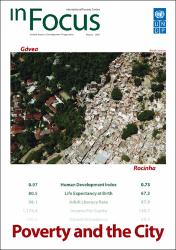Please use this identifier to cite or link to this item:
https://repositorio.ipea.gov.br/handle/11058/15561Full metadata record
| DC Field | Value | Language |
|---|---|---|
| dc.contributor.author | Grinspun, Alejandro | |
| dc.date.accessioned | 2024-10-04T00:00:12Z | - |
| dc.date.available | 2024-10-04T00:00:12Z | - |
| dc.date.issued | 2005 | |
| dc.identifier.uri | https://repositorio.ipea.gov.br/handle/11058/15561 | - |
| dc.description.abstract | "Describing Britain in the 1840s, Benjamin Disraeli famously spoke of “two nations between whom there is no intercourse and no sympathy; who are ignorant of each other’s habits, thoughts and feelings, are formed by different breeding, fed by different food, ordered by different manners, and governed not by the same laws, as if they were dwellers in different zones or inhabitants of different planets… the rich and the poor”. Disraeli’s is a fitting description of the reality in many large cities of the world, where poverty exists amidst concentrated wealth. Sometimes, poverty´s presence is simply just too obvious to ignore — slums and tenements in the middle of a city, beggars near a street light, homeless families eating and sleeping on a sidewalk. As often, it is hidden from the public’s sight, secluded in areas into which better-off residents, and data gatherers, do not normally venture. By 2050, two-thirds of the world’s people will live in cities. Such growth is bound to outstrip the capacity of poorly resourced governments and feeble urban economies to absorb new residents and provide them with adequate jobs, shelter and services. Many if not most will end up in substandard housing in un-serviced and marginal locations, with insecure tenure, limited access to basic amenities and high exposure to health hazards. This month, we devote In Focus to the theme of urban poverty. Accurate estimates of its spread are hard to get. In fact, our opening article argues that official poverty statistics tend to understate the actual scale of need in urban areas of the developing world. This is because standard poverty lines often fail to reflect the real cost of living in a city and to capture key dimensions of well-being, thus neglecting the great scope for improving the lot of the poor through provision of public goods. Housing tenure is especially important for them. In its absence, the urban poor are constantly exposed to the threat of eviction, as vividly described in the articles on Karachi and Lagos that also highlight the failure of formal sector planning to solve the problem of low income housing, the negative impact of market driven real estate development and ill conceived transport policies on the poor, and the institutional abuse and harassment often meted out to them." (...) | en |
| dc.language.iso | en | |
| dc.title | Poverty and the City | en |
| dc.type | Policy In Focus | |
| dc.rights.holder | International Policy Centre for Inclusive Growth | |
| dc.rights.holder | United Nations Development Programme | |
| dc.location.country | Brasil | |
| dc.description.physical | 20 p. : il. | |
| dc.rights.type | Licença total exclusiva | |
| dc.rights.license | O texto e dados desta publicação podem ser reproduzidos desde que as fontes sejam citadas. Reproduções com fins comerciais são proibidas. | |
| dc.subject.keyword | Poverty | |
| dc.subject.keyword | city | |
| ipea.access.type | Acesso Aberto | |
| ipea.researchfields | N/A | |
| ipea.classification | Cooperação Internacional. Relações Internacionais | |
| ipea.classification | Desenvolvimento Social | |
| ipea.classification | Direito. Legislação | |
| ipea.classification | Habitação | |
| Appears in Collections: | Publicações do IPC-IG | |
Files in This Item:
| File | Description | Size | Format | |
|---|---|---|---|---|
| en_IPCPovertyInFocus7.pdf | 453.06 kB | Adobe PDF |  View/Open |
Items in DSpace are protected by copyright, with all rights reserved, unless otherwise indicated.

